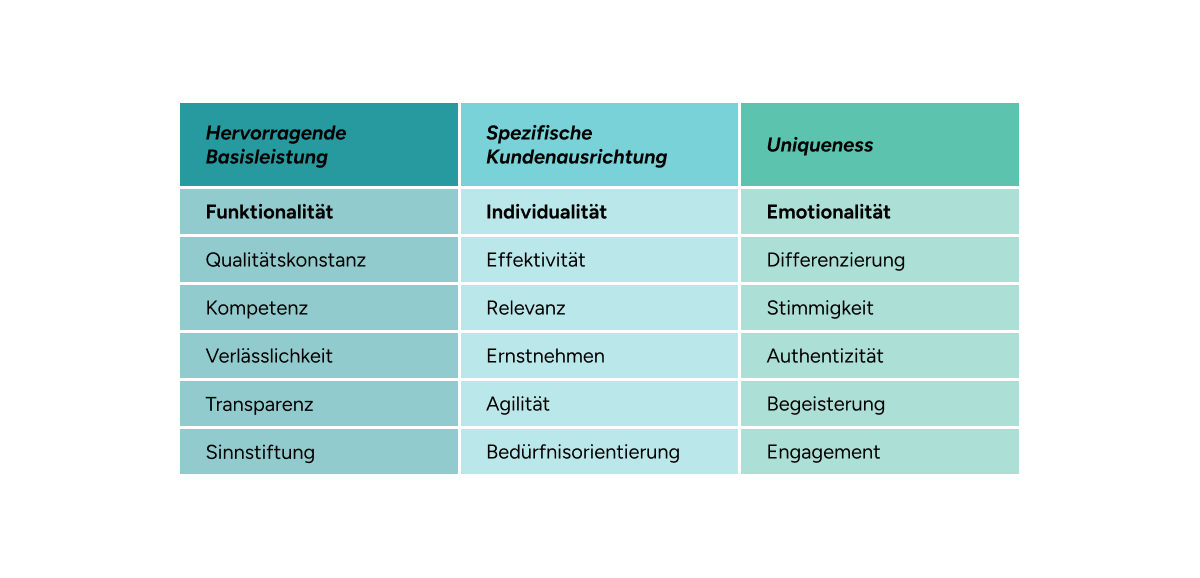
Auf die Wirkung kommt es an!
«Spieglein, Spieglein an der Wand, wer ist die Schönste im ganzen Land?» Manchmal fragen wir uns das auch, oder? Wo wir selbst stehen, in der Gunst der anderen. Denn wir wissen, dass die Wirkung, die wir auf andere haben, entscheidend für den Zuspruch ist, den wir erhalten. Dass dabei die Schönheit eine sehr wichtige Rolle spielt, verneinen nur die wenigen Rationalisten unter uns. Aber dass es neben der Schönheit auch auf die Relevanz und die Sinnhaftigkeit ankommt, kann keiner verneinen.
Die Wirkung der Unternehmen wird von diesen drei wichtigen Werten bestimmt: dem Schönheitswert, dem Nützlichkeitswert und dem Wahrheitswert. Dieser Dreierkanon wirkt immer in der Beurteilung dessen, was uns umgibt, und so beurteilen die Kunden und Kundinnen auch das, was sie von Unternehmen erhalten, entlang dieser drei Werte. Je wertvoller die Wirkung für die Kunden, desto wertvoller wird so das Unternehmen selbst!
Die Kürung von Kunden ist somit eine wichtige Aussage darüber, ob Unternehmen wertvoll sind, und daher wollen viele Unternehmerinnen und Unternehmer wissen, wie sie denn so «wahrgenommen» werden. Kundenzufriedenheitsbefragungen sagen dabei aus, ob das Unternehmen wahrhaftig leistet, ob es einen Wahrheitswert hat. Conjoint-Analysen können hinterfragen, ob die Nützlichkeit auch gegeben ist, um sie dann ebenfalls mit Zufriedenheitsmessungen oder Weiterempfehlungsraten bewerten zu lassen. Letztlich kann auch der Schönheitswert bewertet werden, indem man zum Beispiel die Markenpräferenz erfasst oder die Designqualität küren lässt.
Für Unternehmen sind Bewertungen von jenen Kunden, die zählen, überlebenswichtig. Jene, die zählen, sind zufriedene und loyale Kunden, die ein Unternehmen tragen und unterstützen. Denn diese sind bereit, mehr für das Unternehmen zu tun, machen Preisentwicklungen eher mit und empfehlen das Unternehmen gerne weiter. Aber damit sie dies tun, müssen sie ausreichend überzeugt sein – sie müssen begeistert sein! Daher wollen Unternehmen wissen, ob sie ihre Kunden begeistern und vor allem, in welchem Masse sie das tun. So entstehen viele Rückmeldungen, die Aufschluss darüber geben, ob das Produkt Qualität liefert, ob die Kunden für sie relevante Lösungen erhalten oder ob die Marke sich gegenüber anderen differenzieren kann.
Die hohe Kunst der Kundenbefragung
Erhoben werden diese Daten in der Regel von den Abteilungen, die sich hier verantwortlich fühlen: Die Entwicklung fragt nach der Qualität, das Marketing nach der Relevanz und die Strategie nach der Reputation. Alles schön in den Silos, aus denen auch die Bestandteile einer Kundenleistung erbracht werden (siehe Artikel «Zum Kunden führen!»). Und hier entsteht oft das Problem, das sich in vielen Unternehmen bemerkbar macht: Die Wirkung auf den Kunden ist immer ganzheitlich. Kunden nehmen ein Unternehmen immer ganzheitlich wahr, doch die Unternehmen arbeiten und denken in Silos. Um die Stimme des Kunden wirklich deuten zu können, müssen die Unternehmen die Wirkungszusammenhänge ihrer Aktivitäten kennen.
Damit man den Wirkungszusammenhang aller Resultate aus der Produktentwicklung, dem Marketing sowie den Branding- und Designaktivitäten deuten kann, benötigt man einen Bewertungsansatz, der dies aus Kundensicht erfasst. Idealerweise dergestalt, dass er dabei berücksichtigt, ob das Unternehmen wirklich an die Kunden denkt und diese ins Zentrum ihrer Bemühungen stellt. So lässt sich aufzeigen, ob Kundenzentrierung eine positive Wirkung entfacht und ob diese auch im Zusammenhang aller Unternehmensresultate gegeben ist. Nur wirklich kundenzentrierte Unternehmen können das Silo-Denken überwinden, weil alle Mitarbeitenden in ihrer Arbeit den zentralen Purpose (Zweck) vor Augen haben: Dem Kunden zu dienen!
Die Wahrnehmung der Kunden
In Zusammenarbeit mit Unternehmen aus der Schweiz hat die Hochschule Luzern einen Bewertungsansatz empirisch hergeleitet, der die Kundenwirkung aufzeigt: den Customer Impact Score (Abb. 1).

Dieser Score zeigt anhand einer Kundenbefragung auf, wie sich Kundenzentrierung im Resultat (dem Outcome) der Unternehmen widerspiegelt. Erleben Kunden eine konsistente Funktionalität (ist es wahr, was man erlebt?), erhalten sie, was sie benötigen (ist es nützlich, was man erlebt?) und werden sie begeistert (ist es schön, was man erlebt?). Das Verdikt der Kunden ist hier immer ein Ganzheitliches: Kunden erkennen die verschiedenen Aspekte der Unternehmensarbeit, aber sie urteilen letztendlich auf der Basis eines Gesamteindrucks. Wenn zum Beispiel ein Unternehmen gute Bewertungen für seine Funktionalität erhält, aber in der wahrgenommenen Emotionalität nicht überzeugt, ist die Gesamtwirkung halt mittelmässig.
Es kommt auf das Ganzheitliche an!
Sobald ein Anbieter eine gleich qualitative Funktion anbietet, aber dabei emotionaler ist, ändert sich die Präferenz der Kunden und sie entscheiden sich für den höheren Impact. Und da gerade die Emotionalität eine hoch individuelle Wahrnehmung ist, kann es auch verschiedene Anbieter mit gleicher Funktionalität geben: Was den einen begeistert, lässt den anderen womöglich kalt.
Es ist also vor allem die Fähigkeit, seine Kunden emotionalisieren zu können, was Unternehmen erlaubt, den Impact zu steigern. Die Kompetenzen in Marketing, Branding, Design und Kommunikation sind hier ausschlaggebend. Aber halt nur, wenn sie im Einklang mit der Funktionalität des Unternehmens daherkommen! Kunden merken einfach sofort, wenn ein Unternehmen „Perle vor die Säue“ wirft. Der Wirkungszusammenhang wirkt – in allem!
Und wer ist Nummer Eins im Lande?
Da fragt sich, wer denn nun in der Gunst der Kunden den höchsten Wert verbuchen kann. Wer erzeugt die grösste Wirkung auf Kunden und darf eine wertfördernde Bewertung für sich verbuchen? Dass sich es lohnt, in Kundenwirkung zu investieren, zeigt die letzte Erhebung des CI-Scores recht deutlich (Abbildung 2).

Viele Unternehmen haben Potenzial für Verbesserung, und jenes, ganz unten in der Gunst der Kunden, das gibt es nicht mehr… Daher startet jetzt der Customer Centricity Award, der auf Basis der Kundenwirkung jene Unternehmen kürt, die den grössten Zuspruch erhalten. Und dies nicht, weil eine Jury dies bestimmt, sondern weil wirkliche Kunden ihr Urteil fällen und damit bestimmen, wer wirklich die «Schönste» ist, im ganzen Land!
Customer Centricity Award 2025
Der Customer Centricity Award wird 2025 erstmalig an Unternehmen im deutschsprachigen Raum verliehen, die in Sachen Kundenzentrierung am meisten punkten. Unsere Jury sind Ihre Kunden: Mittels einer systematischen Befragung Ihrer Kunden wird der sogenannte Customer Impact Score® erhoben.
Weitere Informationen finden Sie hier.



